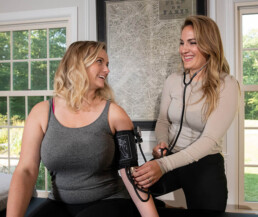Pelvic Floor Physical Therapy
The search for a good PT can be overwhelming, especially for something like Pelvic Floor dysfunctions. But don't worry, you’ve come to the right place to start healing and feel better.
Register for Classes
Now offering Yoga, Pilates, Meditation, and Acupuncture.
6 Week Mini Series for the Pelvic Floor – Registeration is filled.
Get notifications about new classes.
Mobile PT Specializes in Pelvic Floor Treatment
Treating Pelvic Floor Dysfunctions

Christina Klausner specializes in pelvic floor physical therapy with a holistic approach. Working alongside her patients to put all the pieces of the puzzle together, Christina provides the most efficient care with optimal results of a lifestyle her patients always envisioned.
Physical therapy is most effective when it is one on one, with extensive communication, examination of the entire body and its functions. Physical therapy should have long term effects with the ultimate goal for patients not to rely on practitioners for guidance, but rather to trust the body to adapt and adjust to increase efficiency and quality of movement to minimize discomfort.
Pelvic floor treatments can help:
- Pubic symphysis dysfunctions
- Postpartum
- C sections
- Tears
- Vaginal delivery
- Vaginal birth after C section
- Broken tailbone (coccydynia)
- Urge and stress incontinence (leakage)
- Immediate postpartum fundamentals
- Scar mobilizations
- Sacroiliac dysfunction
- Hip pain
- Low back pain
- Hemorrhoids
- Rectal incontinence
- Constipation
- Diastasis Recti
- Bladder
- Rectal
- Bladder
- Uterine
- Rectal
- Scar mobilization
- Desensitization
- Heartburn
- IBS
- Bloating
- First time periods (teens)
- Bloating, pain
- Vaginismus
- Bed wetting
- Constipation
- Anxiety with bathroom habits
- Athletes with leaking during events
- Pain in low back, pelvic, hip area
- Post op care
- Minimizing pain/discomfort
Process
Evaluation and Treatment
Your first session is an evaluation and treatment. During this time, your physical therapist will begin your journey to improve quality of life. Treatment is rendered as your physical therapist progresses through their evaluation.
Treatment Sessions
Treatment sessions are then scheduled and all dysfunctions that are present at the time of your session will be addressed and treated. Each session will be dictated by your body’s needs. An evolution of exercises is prescribed with each session because your body is now changing and so should exercises to reflect this change.
Home Exercise Program (HEP)
Home exercises tend to be tedious and not very motivating; instead Christina seamlessly incorporates exercises in your daily routine. Because what mom has time to dedicate even 5 minutes to getting to the floor and moving? This in turn has proven to have great carry over into managing symptoms long term.
Progress
Within a matter of a few sessions, you will see the light at the end of the tunnel, your goals are attainable. Your discharge process begins here; this is where increased independence of exercises is given and customized for you and your needs, your frequency of visits is decreased and a check in by your PT will lead you to your ultimate goal.
Discharge
Discharge is when your body is at its best and you have achieved your goals. This is the time to return back to all activities without apprehension.
Continuing Care
Upon discharge, we offer classes designed for patients who have just been recently discharged and want to return to some sort of group exercise. Take our fundamentals to the work out and set yourself up for long term success.
Treatments
Each session will be dictated by your body’s needs. An evolution of exercises is prescribed with each session because your body is now changing and so should exercises to reflect this change.
Pregnancy
- First trimester
- Strength training
- Learning about the changes in the body
- Managing incontinence
- Managing constipation
- Address back pain
- Second Trimester
- Continue to strengthen
- Manage bowel and bladder habits
- Strategize on body mechanics
- Importance of nutrition and sleep
- Prepare for labor and delivery
- Third Trimester
- Focus on preparing for labor and delivery with partner
- Keep active within latest guidelines
- Prepare for postpartum recovery with your little one
- Manage bowel and bladder health
- Changes with sex
- Diastasis Recti
- Pubic symphysis dysfunctions (PSD)
- Hemorrhoids
- Managing back pain
- Tailbone pain (coccydynia)
- Sacroiliac dysfunction (SIJ)
- Hip Pain
- Discomfort with moving around
- Pain with sex
Postpartum immediate to 40 years out
- Initial healing after baby
- After C sections
- After Vaginal delivery
- Forceps, episiotomy, tearing
- Healing after 6 weeks and beyond to return to your goals
- Diastasis Recti
- Birthing hip patterns
- Broken tailbone (coccydynia)
- Urge and stress incontinence (leakage)
- Scar mobilizations
- Sacroiliac dysfunction (SIJ)
- Hip pain
- Low back pain
- Hemorrhoids
- Rectal incontinence
- Constipation
- Pain with sex
- Mid back pain
- Foundations to better mechanics when carrying babies
- Preparing the body for another pregnancy
- Hysterectomy
Periods
- Managing pain
- First menses
- Irregular periods
- Bowel and bladder habits during period
Pediatrics
- Incontinence
- Prolapse
- Bed wetting
- Constipation
- Potty Training
- Sensory
- Puberty
- Pre-teen changes
Frequently Asked Questions
Let’s first discuss its location. It is a group of muscles that are located at the bottom of the torso, in the pelvis (where your hips connect to), located right by your private areas. It’s main functions are to assist with keeping your organs in, sexual function, bowel and bladder movement, stabilization of the ENTIRE body.
This small group of muscles work with some other key muscles to allow the body to work in the most efficient way. If there is any dysfunction to this or its partners, the balance of our bodies will be off and often cause discomfort that may not be directly related to that area but away from it.
Our bodies are amazing things; they are experts in adapting and adjusting to achieve outcomes, however it is not always efficient, and this is where pain can start; which in turn can turn into a snowball effect.
However, a physical therapist can reset your body to work in the most optimal ways and get you towards your personal goals, whatever they may be and you do not have to just live with it or continue to be dismissed for your symptoms.
Results will be immediate, and it will motivate you to continue towards progress. This is the type of specialty Christina Klausner practices.
Yes, this is one-on-one physical therapy and with the ever changing needs to adapt to our families, you can of course have your children present at the time of treatment.
For all moms of newborns, we will travel to your home in order to minimize exposure and adjust to your schedule as we know newborns need change constantly.
No, New Jersey is a direct access state, meaning you can see your physical therapist at any time you feel is necessary for you
It is always in the best interest of the patient to keep all their practitioners informed of your care. If you recently had a baby, or are in your first trimester, you should have clearance from your OBGYN for any internal exams.
If you and your physical therapist feel it is appropriate and it would benefit your treatment/evaluation. You will also have access to a neutral party in the room during exams.
At this time, we are out of network with all insurances. If you have a health savings account, you can use that to pay for services and a superbill (a bill with codes needed for insurance) will be provided to you to apply toward your out-of-network deductible or towards your HSA.
On average our patients have 3-5 visits and then as needed with long-term outcomes. Everybody is addressed as a whole. All symptoms are connected and have an impact on the pelvic floor. Even though the pelvic floor is the niche of this practice, all concerns are addressed at the time of each session, which in turn has long-term carryover and a high success rate.
Yes! It is so important to address all pelvic needs at an early stage so as they develop and grow, these issues are a thing of the past.
Yes, however, not in pelvic floor dysfunctions internally.
Oftentimes, clients will come in with aches and pains that don’t fit the diagnostic criteria, but it impacts their lives. We take a deep dive into their past and address every obstacle to figure out what is the root cause. We treat the dysfunction and not the symptom.
Pelvic Floor Physical Therapy addresses all incontinence, constipation, potty training, sensation, overactive bladder, puberty and its impact on the social, emotional, and functional components of life. A full assessment of the child, which encompasses their development, all medical notes, parent-child relationship, and personal experiences, help your physical therapist understand the bigger story. From here, a plan is made with the child, parent, and PT to help with pelvic floor dysfunctions. No Internal exams are performed. Success is achieved by getting the child involved, problem solving through their own needs, and working with all involved in their care.

Get our Newsletter
Sign up for tips on maintaining good pelvic health, self-care routines, resources and more!
